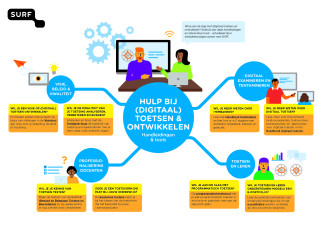Digital testing
Digital testing and assessment explained

Testing and assessment are essential parts of the educational process. In recent years, the approach to testing in higher education has significantly evolved. Firstly, educational institutions are increasingly conducting tests digitally. At many institutions, the demand for digital testing now exceeds capacity.
Additionally, perspectives on testing have shifted in recent years. There is more emphasis on testing as a learning tool rather than merely an assessment tool. Many educational institutions want to adopt “development-oriented testing,” which introduces new needs, such as digitally monitoring students’ progress and providing feedback. Institutions are seeking digital tools, like dashboards and e-portfolios, to support this approach.
Testing is at the heart of education, and perspectives on testing are changing. The focus is increasingly on formative aspects – the learning process. Additionally, the digitization of testing has accelerated. These developments present significant challenges for education.
What issues are at play in digital testing?
In digital testing and assessment, we focus on the following topics:
Safe and flexible testing
The demand for secure and flexible digital testing environments is growing rapidly. Institutions increasingly want to conduct tests on mobile devices (laptops). This can be done using institution-managed laptops or students’ own devices – also known as Bring Your Own Device (BYOD). Institutions need insights into the pros and cons and step-by-step guidance on implementation. Testing with BYOD also raises ethical issues, such as inequality of opportunity. Furthermore, there is a desire for collective engagement in discussions with commercial Edtech providers.
Authentic assessment
There is a growing need for authentic forms of assessment. This means that students may need to use applications like Excel, Matlab, or SPSS during exams. How do you prevent fraud in these cases?
Development-oriented testing
Many educational institutions want to implement “development-oriented testing.” This creates new needs, such as digitally monitoring students' development and providing feedback. Institutions are looking for digital tools, such as dashboards and e-portfolios, to support this approach.
Vision development
In 2022, SURF, together with the Testing Workgroup of the Acceleration Plan, developed the document Future Perspectives on Digital Testing to gain insight into the future of testing. Following this, SURF developed the Testing Vision Tool, which helps institutions clarify their vision on digital testing and assessment. We aim to clarify what the testing landscape will look like in Dutch higher education and vocational education over the coming years and identify areas where SURF can collaborate.